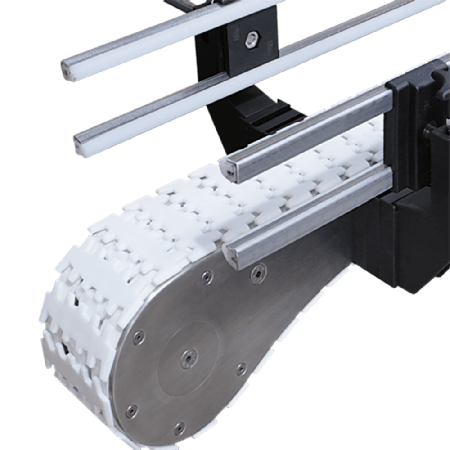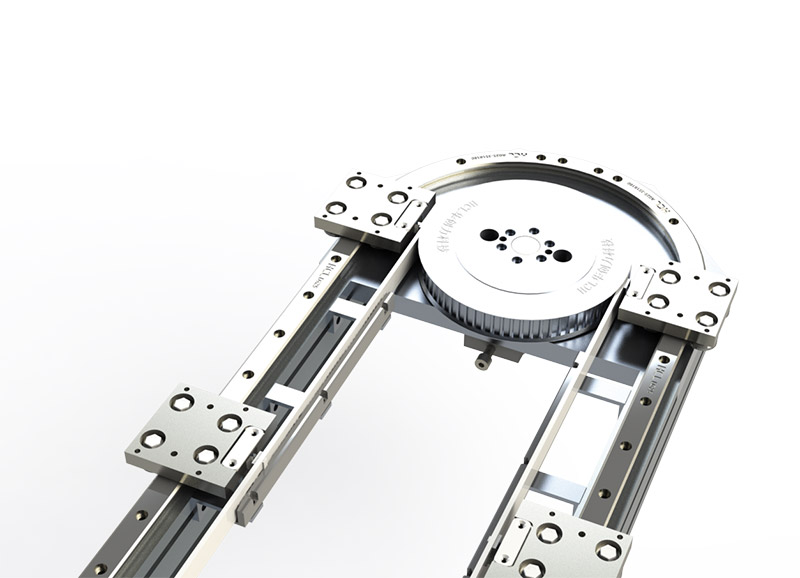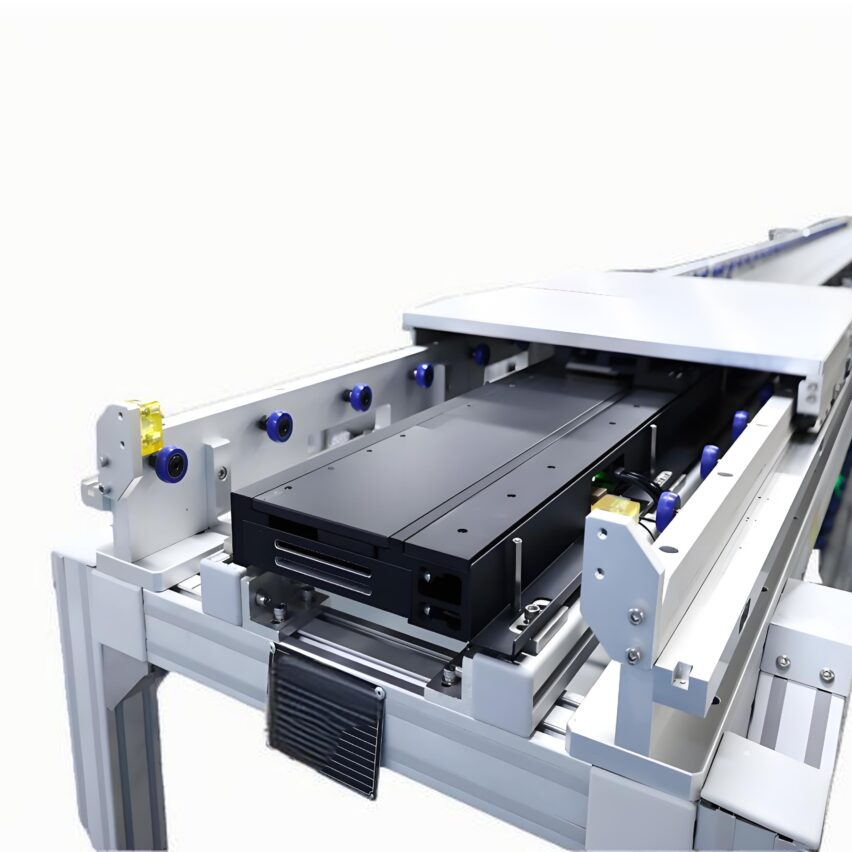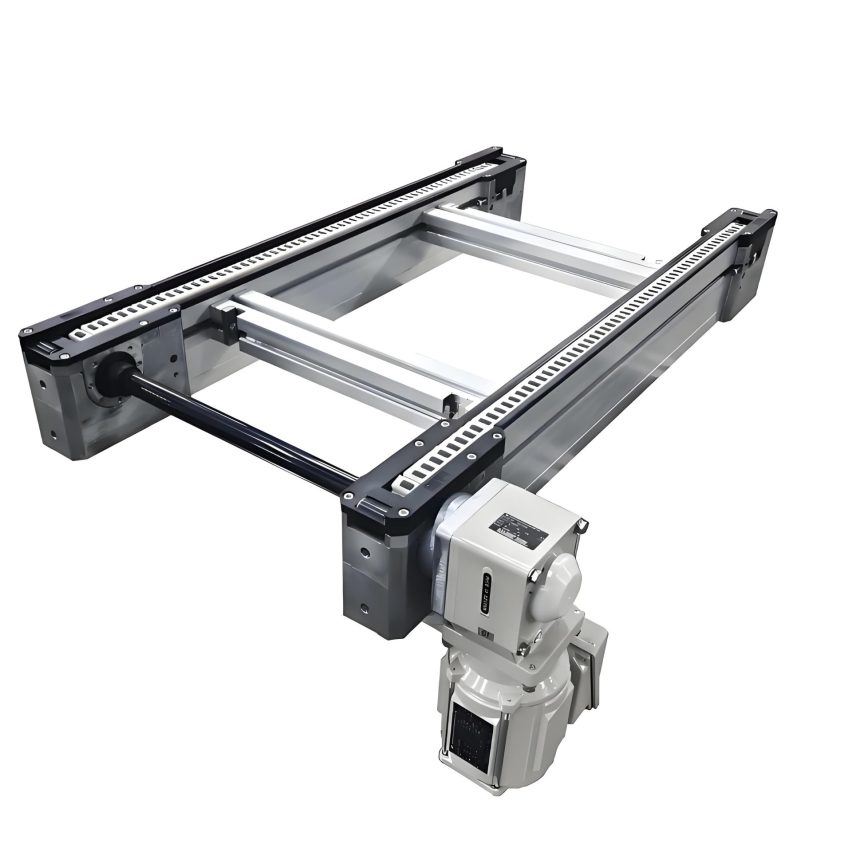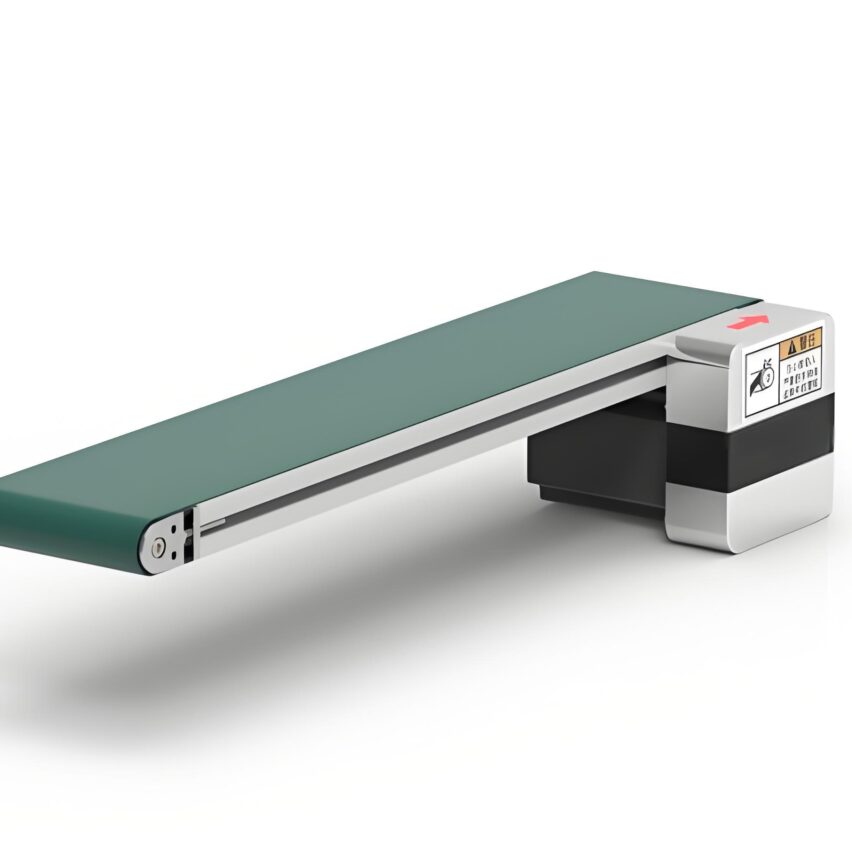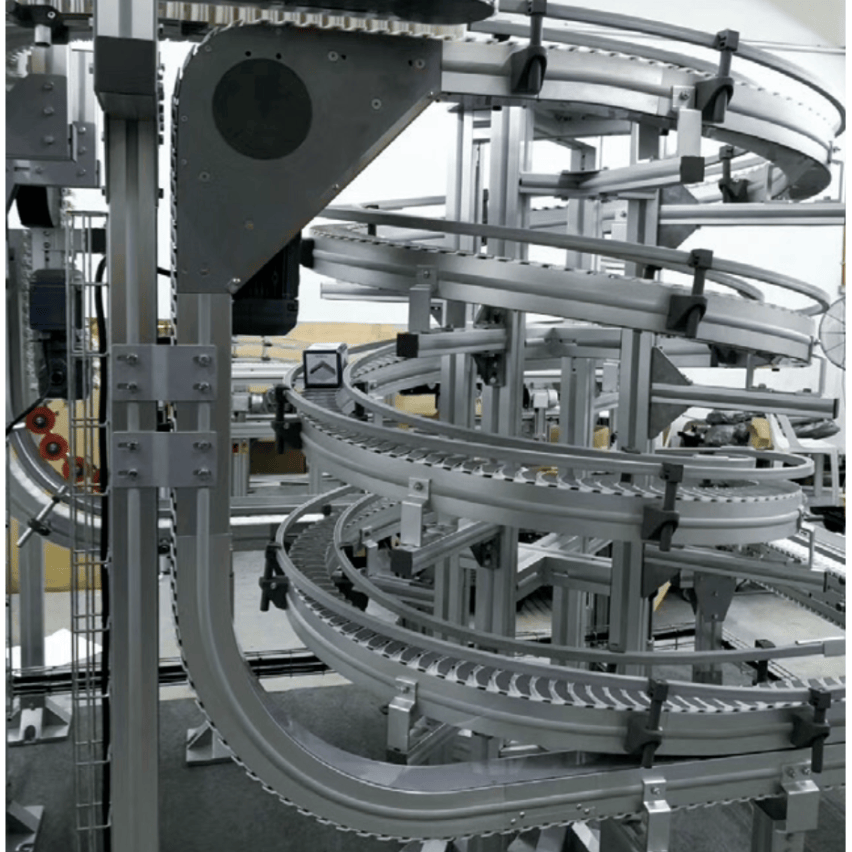The core principle and structural innovation of the multiplier chain
The essence of an automated multiplier chain conveyor line is that byMechanical differential designAn efficiency leap is realised. At the heart of this lies the difference in diameters of the rollers and rollers (D > d), so that when the chain is moving at the base speed V₁, the actual speed of the workpiece plate reaches V₁ x (1 + D/d). For example, a 3x speed chain (D = 2d) allows the workpiece to slide at 3 times the speed of the chain. This structure contains four main modules:
- Differential sprocket systemPassive acceleration" is achieved by generating additional linear velocity through the rotation of the rollers;
- Intelligent Drive Unit: Frequency conversion motor with reducer, precision error is controlled at ±0.5mm;
- Modular guide rails: Aluminium alloy profiles with anodised surfaces, combining lightness and wear resistance;
- Accumulation control system: Photoelectric sensor + PLC to achieve accurate stopping of the work plate, error ≤ 1mm.
In a UAV factory in Shenzhen, I have seen the work plate carrying the wing components in the 3 times the speed of the chain speed, but in the assembly station instantly stationary - this kind of "moving like a rabbit, quiet as a child" dynamic control, is precisely the mechanical design and digital control of the wonderful resonance.
Revolutionary advantages over traditional production lines
The breakthrough of the Speed Chain is reflected in three dimensions compared to belt lines and roller lines:
1. Leap in effectiveness
▶︎load capacity: 2200kg for light-duty models and up to 4000kg for heavy-duty models.
▶︎velocity elasticity: 2-20 m/min stepless speed regulation, adapt to the beat change
▶︎Space utilisationMulti-level meandering design to accommodate kilometres of conveying in 200m2 of space.
2. Flexible evolution
By replacing work plates (steel/engineered plastic/wood) and adjusting chain speed, mobile phones (1.2kg) and server cases (18kg) can be mixed on the same line. The engine line of an automotive company achieved a daily capacity increase of 40%.
3. Cost reconstruction
▶︎power consumption: Material internal friction drive is more energy efficient than screw conveyor 40%
▶︎safeguard: No lubrication chain with 10,000 hours life test, failure rate <0.5%
▶︎conversion cost: Modular design reduces line adjustment time by 70%
But what shocks me most is the case of a photovoltaic plant in Shandong: a hybrid layout of multiplier chains and magnetic levitation segments, which achieves zero-contact transmission while retaining the advantage of heavy loads, and reduces the rate of crystalline silicon fragmentation from 3 per cent to 0.8 per cent--The future belongs to the composite conveyor architecture, rather than a single technology route.
New Paradigm Breakthroughs in Industry Applications
Electronics manufacturing: micron-level control
Dongguan mobile phone motherboard assembly line adopts anti-static multiplier chain, the conductive wheel and the conductive row of the work plate to form a closed-loop resistance <4Ω, eliminating the threat of 5kV static electricity. Together with machine vision positioning, the patch yield is increased to 99.97%.
Automotive industry: heavy-duty symphony
On the chassis assembly line of a new energy vehicle plant in Shanghai, 32 work plates are synchronously carrying 1.8 tonnes of bodywork. The servo positioning system ensures that the deviation of each bolt hole position is ≤0.3mm, shortening the beat by 22 seconds compared with the traditional lifting line.
Food and medicine: the hygiene grade revolution
The food grade multiplier chain developed by Wei Chuang adopts nano-coated guide rails with surface roughness Ra≤0.4μm, eliminating microbial residues. It achieves 95℃ high temperature tolerance in dairy filling line, and the colony control is better than GMP standard 30%.
The case of the medical consumables plant is particularly forward-lookingThe chain speed system transports cardiac stents in closed tubes, protected by nitrogen to avoid oxidising the metal. This "invisible transport" is redefining cleanliness standards.
Three Frontier Directions for Intelligent Upgrades
1. Predictive maintenance system
Vibration sensors are embedded in chain links and faults are predicted by FFT spectrum analysis. Unplanned downtime was reduced by 70% and spare parts inventory was reduced by 45% after application in a steel plant.
2. Dynamic topology control
A scheduling system based on 5G edge computing can reconfigure the conveyor path in real time. For example, when the laptop assembly line encounters a faulty workstation, it automatically starts the jacking and panning machine to divert the workpiece.
3. Breakthroughs in energy autonomy
The experimental hydrogen fuel cell drive unit, coupled with a direct photovoltaic supply system, has reduced the energy consumption of Qingdao Port's ore conveying line by 521 TP3 T. The more cutting-edge bio-based chain material has a natural degradation rate of 831 TP3 T six months after end-of-life.
But the lesson of a smart factory in 2024 is a cautionary tale: hacking into the multiplier chain control system led to a series of collisions of tooling boards. This revealsHard protection with physical isolationIt must be built in tandem with cybersecurity - the game of efficiency and risk never ends.
Disruptive trends for the next decade
- Self-healing materialsMicroencapsulated lubricant automatically releases when the chain wears out and lasts up to 3 times longer.
- quantum cryptography: Anti-jamming control system secures commands through quantum key distribution
- bionic structureGecko Foot Adhesion Principle for 90° Vertical Conveying
- magnetorheological revolution: Magnetorheological fluid links with instantaneously adjustable stiffness in the laboratory, dynamic switching of load capacity
A Japanese research institute's magnetic-liquid bimodal chain has broken through the theoretical limits: when normal transport to maintain the rigid body characteristics, in the event of a sudden impact is turned into a viscoelastic state to absorb energy. This "rigid-flexible" design philosophy, or will rewrite the safety standards of conveyor equipment.
Ask yourself the core question.
Q1: How is the "speed" of the speed chain precisely controlled?
▶︎mechanical design: Base multiplier (1.5-3x) locked by roller/roller diameter ratio (D/d)
▶︎dynamic adjustment: Frequency converter real-time adjustment of motor speed, accuracy of ± 0.2m/min
▶︎final brake: Hysteresis dampers to eliminate inertial slip of workpiece plates
Q2: Which scenarios should I prioritise multiplier chains?
- Precise positioning is required (e.g. engine block bore error ≤ 0.5mm)
- Multi-variety mixed production (quick changeover of work plates)
- Harsh environments (dusty workshops require IP65 protection)
- Long-term continuous operation (design life > 5 years)
Q3: How is the return on investment cycle measured?
Take the example of a production line with a capacity of 500,000 notebooks per year:
sports event Conventional drum line doubled speed chain initial investment ¥1.2 million. ¥1.8 million. daily production capacity 1,500 units 2,400 units energy costs ¥83,000/year ¥51,000/year payback period – 14 months Note: The data is derived from a case of transformation of an electronic factory in South China in 2024.




